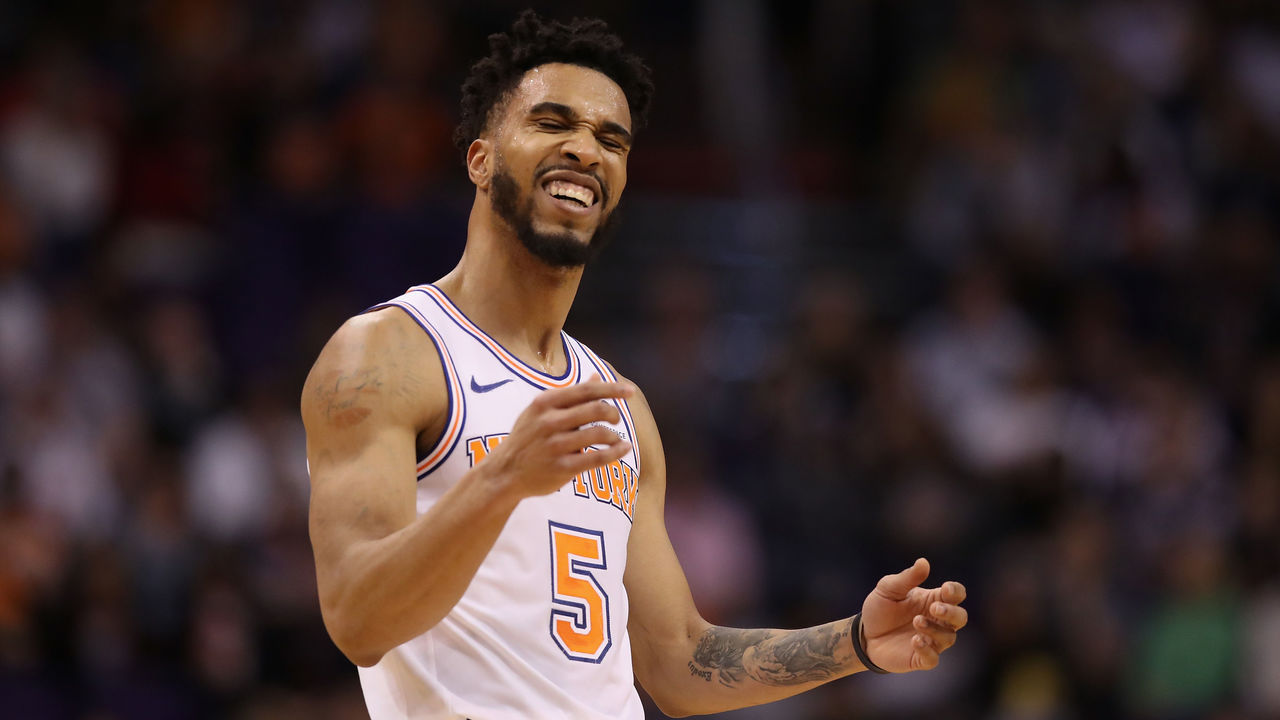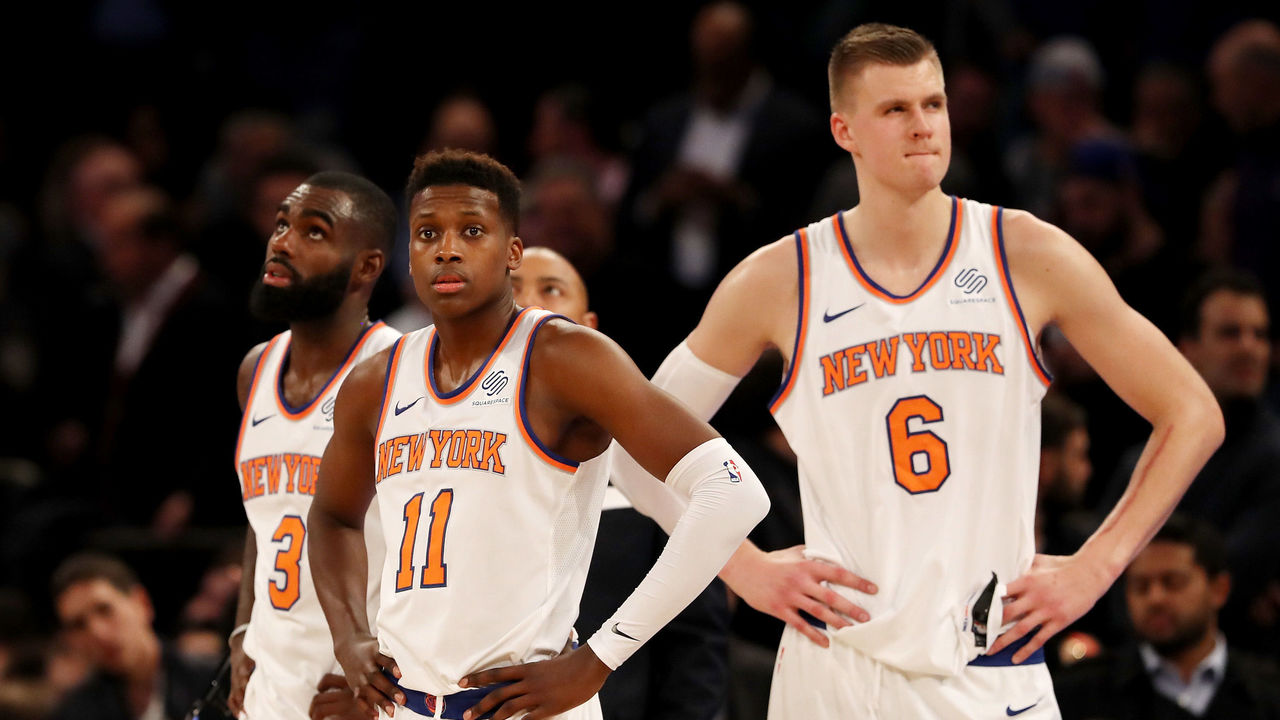Silver Linings Porzingis: Can the Knicks make the best of a bad situation?
Kristaps Porzingis tore the ACL in his left knee Tuesday night, ending his breakout campaign and vaporizing whatever hope or excitement remained in this - and likely the next - New York Knicks season. So, what happens now?
First off, let's be clear: This sucks. It sucks for Porzingis, who - even given his struggles the past couple months - was in the midst of a career season, is about to become extension-eligible, and may take years to get back to where he was. It sucks for the Knicks, who had finally gathered a bit of meaningful forward momentum after years of being, at best, stuck in the mud. It sucks for Knicks fans, and NBA fans, and fans of fun and unique basketballing. It's sad, and it's unfair. It suuucks.
But it happened, and as cynical as it feels to unpack the practical implications of an injury that could affect a man's livelihood, the NBA presses on. The question for the Knicks now becomes how they can make the best of a miserable situation. The fallout will be painful in the short term, but it doesn't have to be enduringly bad. Here are some things to consider as the Knicks look to pick up the pieces and move forward.
Extend or delay?

Porzingis will become eligible for an extension this summer, and before Tuesday night, he seemed like a near-lock to get a five-year max. The injury probably changes that accounting - if not in terms of outcome, at least in terms of timing. Porzingis now has a worryingly long history of ailments in his young career, from his quad to his hip to his ankle to, most recently and disconcertingly, his knee. Injury concerns didn't prevent the 76ers from giving Joel Embiid a max extension, but the Bucks balked at doing the same for Jabari Parker.
Porzingis sits somewhere between those two in terms of stature and ability, and his injury history isn't quite as scary. But the Knicks would risk little by forgoing the extension, seeing how Porzingis looks when he returns next year, and letting him hit restricted free agency. They'd be vulnerable to a predatory offer sheet from another team (like, say, the Lakers, who are reportedly now focused on hoarding cap space for 2019), but would be in control of the situation, with the ability to match any deal.
This could also go in the other direction, instead prompting the Knicks to try signing Porzingis to a below-market extension this summer, when he may be craving security. Would he be willing to bet on himself and pass up that security, given that he'll be returning - in a possibly diminished physical state - just a few months before free agency?
Time to sell

With Porzingis on record imploring the front office to add rather than subtract in the hopes of making a playoff push, the Knicks were almost certainly going to hold onto their productive veterans at the trade deadline, even as they sat four or five games outside the postseason picture.
With Porzingis out for this season and likely the majority of 2018-19, the Knicks will harbor no such delusions, and should be free to try strip the roster down - which will be more beneficial to the long-term health of the franchise. They won't be able to get rid of albatross contracts for Joakim Noah or Tim Hardaway Jr., but they do have a small handful of rotation players on affordable deals (namely, Courtney Lee and Kyle O'Quinn) who appear movable.
The Knicks may not be able to get more than a second-rounder for O'Quinn - who is good and cheap, but can opt out at season's end. However, if they take back an undesirable offsetting contract in exchange for Lee (a 3-and-D wing who's having a career year, and is on the books for about $12 million the next two seasons), they may well be able to extract a first-rounder. Maybe they can even sell a scoring-starved playoff team on Michael Beasley. It won't be sexy, but these are the kind of marginal moves that can make a difference in the big picture. And the Knicks already made a move with the long view in mind by dealing Willy Hernangomez for second-round picks in 2020 and 2021.
The benefit of a pre-deadline sell-off would be twofold: recouping some assets, and precipitating the team's nosedive to the bottom of the standings/surge to the top of the draft lottery.
A chance to start over

The Knicks nailed the most vital step in NBA roster construction when they drafted Porzingis - a potential foundational star - in 2015. They've flubbed virtually ever other aspect of team-building strategy since then: filling the roster out with middling vets while clogging the cap sheet with bloated long-term contracts, all in the vain hope of chasing an 8-seed. Much of the team was built with Carmelo Anthony still in the picture, which means it wasn't designed with the specific intent of surrounding Porzingis with complementary pieces on a similar developmental timeline.
Had they heeded Porzingis' trade-deadline wish, they might have continued along that same track, but this is their chance to do things right. With no pressure or expectation to be competitive, they should play all their young unproven guys as often as possible; hoard assets; tank for high lottery picks the next two years; focus on a draft-and-develop approach; and sit out free agency, unless they're taking cheap fliers on guys who might still have untapped upside (think Mario Hezonja).
That approach could obviously still blow up in their faces - this is the New York Knicks we're talking about, after all. But if they can build up a cadre of young talent around Porzingis (and, to a much lesser extent, rookie point guard Frank Ntilikina), the Knicks' young unicorn may return to find the team in better shape than he left it.
(Photos courtesy: Getty Images)